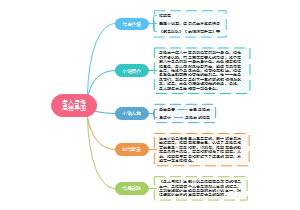导图社区 (新高考)高中英语语法——形容词,副词的用法
- 105
- 3
- 2
- 举报
(新高考)高中英语语法——形容词,副词的用法
详细介绍了高中英语中形容词,副词的用法,搭配经典例句,详细展示了其用法,铁汁们,赶紧学起来吧!!!
编辑于2022-11-24 00:29:05- 英语高考
- 副词的用法
- 相似推荐
- 大纲
形容词,副词的用法
形容词
一.形容词的定义: 形容词表示人或事物的性质, 特征或状态
修饰名词
不定代词
二.形容词在句中的作用:
作定语
作表语
作补语
作主语或宾语
the+adj表示某一类人或事物
作状语
三.关于形容词的作用要注意的问题:
1.有些形容词只能作表语和补语, 不能象普通形容词那样作前置定语, 这样的形容词称为表语形容词。
如: alive, alone, asleep, alike, afraid, awake, ashamed, able, sure, ill, worth等词
2.表语形容词作定语时需后置。
四.形容词在句中的位置:
1.单个形容词作定语时, 一般放在被修饰的名词之前; 两个或两个以上的形容词修饰一个名词时, 同种类形容词的排列顺序一般应考虑以下两种情况:
①.和被修饰的名词关系比较密切的形容词位置更靠近名词。eg:It is a touching English film.
②.音节少的形容词在前, 音节多的形容词在后。eg: I have a small but beautiful room.
2.不同种类的词同时出现在名词前作定语时, 按以下顺序进行排列:限定描绘大长高,形状年龄和新老,颜色国籍出材料,作用类别往后靠。
3.单个形容词作定语时, 在下列情况之下, 形容词应放在被修饰的词之后。
形容词修饰不定代词something, nothing, anything等时应后置
副词
一.副词的种类(一般情况):
①.时间副词,如:often,always,early,now
②.地点副词,如:here,there,above,outside
③.方式副词,如:hard,well,badly,fast,slowly
④.程度副词,如:very,quite,much,still,almost
二.副词在句中的作用: 副词修饰动词, 形容词, 名词, 副词或全句, 在句中的作用如下
1.作状语:
a.You should always review your lessons.
b.The visitors are warmly welcomed by the students.
c.Certainly we should try out best to improve our work.
2.作表语:
a.He is a broad.
b.The class is over.
c.The football match is on.
3.作定语:副词作定语时置于被修饰词之后
a. This is her first day up.
b. The comrades here give us a lot of help.
4.作补语(包括宾语补足语和主语补足语):
a. I found all the lights on when I got home last night.
倍数表达法
A is 倍数(three times/twice) + bigger than B
A is 倍数(three times/twice) + as big as B
A is 倍数(three times/twice) + the size of B
形容词和副词的比较等级
一.原级:
1.原级的形式:即原形
2.原级的用法
①.表示被比较双方在某一方面相等或相同时, 用as + adj / adv + as结构, 表示“…和…一样”
a.Xiao Li is as tall as his sister.
b.It is as cold today as it was yesterday.
c.There are as many seats in this hall as in that hall.
②.表示被比较双方在某一方面不相等或不同时, 用not as + adj / adv + as, 表示“…和…不一样”
a. Xiao Li is not as tall as his brother.
b. It is not so cold today as yesterday.
c. There are not so many seats in this hall as in that hall.
二.比较级和最高级:
1. 比较级的用法: 两方进行比较时, 多用than
a. It is colder today than it was yesterday.
b. His handwriting is more beautiful than yours.
c. He did his homework more carefully than you did yours.
2.最高级的用法: 三方或三方以上进行比较时, 用最高级, 最高级前多用the, 基本形式为: the + adj / adv的最高级 + (名词) + 表示范围的短语或从句
3.比较等级的特殊用法:
①.有些词的比较级和最高级有两种不同形式, 意义上也有所不同, 如: older / oldest(比较老/最老的), elder / eldest (年龄比较大的/最大的); farther / farthest用于本义, 表示“比较远的/最远的”, 而further / furthest常用于引申意义, 表示“更进一步的,更深一层的/最深层的”
②.表示“比…多(大)几倍”时, 用“倍数+ as…as” 结构或“倍数+比较级+than…”表示
a. This book costs twice as much as that one.
b. The university is three times as big as it was in 1980. =The university is three times bigger than it was in 1980.
③.比较级+ and +比较级表示“越来越…”的意思
a. Summer is coming. It is getting hotter and hotter.
④. “the +比较级+主语+谓语+其他, the +比较级+主语+谓语+其他” 表示 “越… , 就越…”的意思
a. The harder you study, the more knowledge you will get.
b. The more you work for other people, the happier you will feel.
⑤.more…than…有时表示“与其说…, 倒不如说…”
a.. He is more diligent than wise.与其说他聪明,不如说他勤奋
b. He is more a friend than a teacher.与其说他是一位老师,不如说更像一位朋友
⑥“no+比较级+than…”和“not +比较级+than…”所表示的意思不相同, 前者表示“和…一样不…”(即两者都不…), 后者表示“不比…更… ”(仅否定前者, 即表示前者不如后者) no more than 只是,仅仅 not more than至多,不超过
a. His English is no better than mine. (两人的英语都不好)
b. His English is not better than mine. 他的英语不如我的英语好(仅否定 “他的英语”)
⑦.否定词+比较级,表示最高级, 如:
a. It can’t be safer.再安全不过了.
b. She can’t be more beautiful. 她简直美极了
⑧. “the +序数词+最高级” 表示“第几”之意
a. China is the third largest country in the world.
b. The Yellow River is the second longest river in China.









